Follow-on question to this one.
I am trying to generate and save a series of images. Rendering is done by Helix Toolkit, which I am told utilises the WPF composite render thread. This is causing problems because it executes asynchronously.
My original problem was that I couldn't save a given image because it hadn't yet been rendered at that time I was trying to save it. The above answer provides a workaround to this by putting the 'save' operation inside an Action which is called with low priority, thus ensuring that the rendering completes first.
This is fine for one image, but in my application I require multiple images. As it stands I cannot keep control of the sequence of events because they occur asynchronously. I am using a For loop which just continues regardless of the progress of rendering and saving the images. I need the images to be generated one by one, with enough time for rendering and saving before starting the next one.
I have tried putting delays in the loop but that causes its own problems. For instance an async await as commented in the code causes cross-threading issues because the data was created on a different thread from where the rendering is being done. I tried putting in a simple delay but then that just locks everything up - I think in part because the save operation I am waiting on has very low priority.
I cannot simply treat it as a batch of separate unrelated asynchronous tasks because I am using a single HelixViewport3D control in the GUI. The images have to be generated sequentially.
I did try a recursive method where SaveHelixPlotAsBitmap() calls DrawStuff() but that wasn't working out very well, and it doesn't seem a good approach.
I tried setting a flag ('busy') on each loop and waiting for it to be reset before continuing but that wasn't working - again, because of the asynchronous execution. Similarly I tried using a counter to keep the loop in step with the number of images that had been generated but ran into similar problems.
I seem to be going down a rabbit hole of threading and asynchronous operations that I don't want to be in.
How can I resolve this?
class Foo {
public List<Point3D> points;
public Color PointColor;
public Foo(Color col) { // constructor creates three arbitrary 3D points
points = new List<Point3D>() { new Point3D(0, 0, 0), new Point3D(1, 0, 0), new Point3D(0, 0, 1) };
PointColor = col;
}
}
public partial class MainWindow : Window
{
int i = -1; // counter
public MainWindow()
{
InitializeComponent();
}
private void Go_Click(object sender, RoutedEventArgs e) // STARTING POINT
{
// Create list of objects each with three 3D points...
List<Foo> bar = new List<Foo>(){ new Foo(Colors.Red), new Foo(Colors.Green), new Foo(Colors.Blue) };
foreach (Foo b in bar)
{
i++;
DrawStuff(b, SaveHelixPlotAsBitmap); // plot to helixViewport3D control ('points' = list of 3D points)
// This is fine the first time but then it runs away with itself because the rendering and image grabbing
// are asynchronous. I need to keep it sequential i.e.
// Render image 1 -> save image 1
// Render image 2 -> save image 2
// Etc.
}
}
private void DrawStuff(Foo thisFoo, Action renderingCompleted)
{
//await System.Threading.Tasks.Task.Run(() =>
//{
Point3DCollection dataList = new Point3DCollection();
PointsVisual3D cloudPoints = new PointsVisual3D { Color = thisFoo.PointColor, Size = 5.0f };
foreach (Point3D p in thisFoo.points)
{
dataList.Add(p);
}
cloudPoints.Points = dataList;
// Add geometry to helixPlot. It renders asynchronously in the WPF composite render thread...
helixViewport3D.Children.Add(cloudPoints);
helixViewport3D.CameraController.ZoomExtents();
// Save image (low priority means rendering finishes first, which is critical)..
Dispatcher.BeginInvoke(renderingCompleted, DispatcherPriority.ContextIdle);
//});
}
private void SaveHelixPlotAsBitmap()
{
Viewport3DHelper.SaveBitmap(helixViewport3D.Viewport, $@"E:\test{i}.png", null, 4, BitmapExporter.OutputFormat.Png);
}
}
